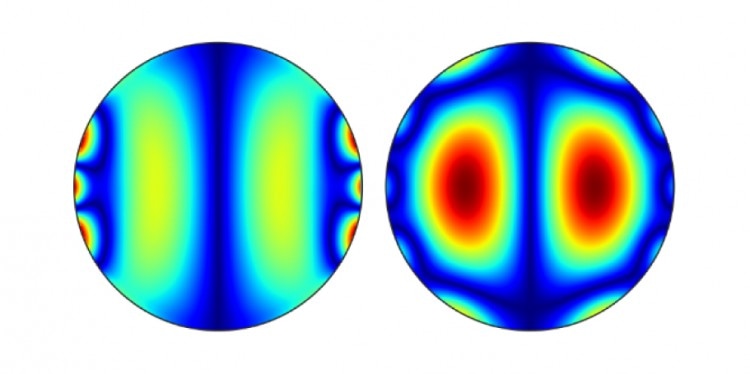Nov 25 2019
For many years, electronic device developers have been trying to make faster, smaller, and more energy-efficient devices.
 Magnetic simulations for magnetic disks measuring 0.5 µm in diameter. The spatial distributions of dynamic magnetization in permalloy (left) and cobalt and nickel (right) can be seen. Image Credit: © B. Divinskiy et al./Nature Communications.
Magnetic simulations for magnetic disks measuring 0.5 µm in diameter. The spatial distributions of dynamic magnetization in permalloy (left) and cobalt and nickel (right) can be seen. Image Credit: © B. Divinskiy et al./Nature Communications.
For instance, to reduce the size of the individual components of computers or mobile phones, magnetic waves are now considered as potential alternatives to traditional data transmission functioning through electric currents.
The reason is as chips turn out to be increasingly smaller, the transmission of electrical data reaches its limits at a certain point. This is because electrons that are extremely proximal to one another emit plenty of heat, which can disrupt physical processes. On the contrary, high-frequency magnetic waves have the ability to propagate in even the tiniest nanostructures and can, therefore, transmit and process data.
The so-called electron spin in the magnetic material forms the physical basis for this. This magnetic material can be defined as a spin of the electron around its own axis. But to date, the use of spin waves in microelectronics has been rather limited because of the so-called damping. The damping acts on these spin waves and eventually weakens them.
At the University of Münster (Institute for Applied Physics, Research Group Demokritov), physicists have recently devised a novel method that removes unnecessary damping and renders it more convenient to utilize spin waves.
Our results show a new way for the application of efficient spin-driven components.
Dr Vladislav Demidov, Study Lead, Institute for Applied Physics, University of Münster
The latest method may prove useful in upcoming advances in microelectronics and also for additional studies into new computer processes as well as quantum technologies. The research has been published in the Nature Communications journal.
Background and Method
The research field is known as magnonics, where researchers analyze electron spins as well as their waves present in magnetic materials. This name was obtained from the particles of magnetism, which are referred to as magnons relating to spin waves.
The so-called spin Hall effect offers the ideal method to electronically offset the spin waves’ disturbing damping. The spin Hall effect was identified some years ago. Based on the orientation of their spin, the electrons existing in a spin current are deflected sideways. This makes it viable to efficiently produce and regulate the spin waves present in magnetic nano-devices.
But the oscillations contain the so-called nonlinear effects that impact the proper working of the spin Hall effect in real-world applications; this is one of the reasons why researchers have not achieved the damping-free spin waves yet.
The researchers carried out an experiment in which they placed magnetic disks composed of nickel and cobalt, or permalloy—which has a thickness of only a few nanometers—on a thin platinum layer. The so-called magnetic anisotropies acted on different materials’ interfaces, meaning that the magnetization occurred in a specified direction.
When the scientists balanced the anisotropies of the diverse layers, they efficiently suppressed the unwanted nonlinear damping and thus obtained coherent spin waves—that is, waves whose waveform and frequency are the same and which hence have a permanent phase difference. This phenomenon allowed the investigators to realize complete damping compensation in the magnet system, thereby enabling the waves to propagate in a spatial manner.
According to the researchers, their latest technique will have a major impact on upcoming developments in spintronics and magnonics.
Our findings open a route for the implementation of spin-Hall oscillators capable of generating microwave signals with technologically relevant power levels and coherence.
Boris Divinskiy, PhD Student, Institute for Nonlinear Magnetic Dynamics, University of Münster
Divinskiy is also the study’s first author.
The German Research Foundation and the National Science Foundation of the United States funded the study.